Study on Micro-Crack Induced Precision Severing of Quartz Glass Chips
Abstract
:1. Introduction
2. Micro-Crack Induced Severing of Brittle Workpiece
3. Modelling of Severing Force
4. Micro-Grinding of Microgroove on Workpiece Surface
5. Experiment and Measurement
6. Results and Discussions
6.1. Profile of Micro-Ground Microgroove on Workpiece Surface
6.2. Severing Surface Topography
6.3. Loading Force and Loading Time versus Loading Rate
6.4. Severing Force versus Microgroove-Apex Radius and Loading Rate
6.5. Prediction of Severing Force
6.6. Ideal Severing Force versus Microgroove Angle and Height
6.7. Severing Time versus Microgroove-Apex Radius
6.8. Severing form Errors versus Loading Rate
6.9. Severing Surface Roughness versus Loading Rate
6.10. Cracking Propagation Time and Loading Positions
7. Conclusions
- Compared to a mechanical rolling scribe, the micro-crack-induced severing by a non-cracked microgroove-apex produces smooth severing edges without any breakages, median cracks, radial cracks and lateral cracks. The micro-grinding may machine the accurate and smooth microgroove-apex without any cracks.
- In micro-crack-induced severing, the crack propagation occurred at the same time from the microgroove-apex and the loading point. The severing efficiency is dominated by the severing time rather than the crack propagation time. The severing energy and quality depend on the loading rate.
- When the loading rate was less than 20–60 mm/min, the dynamic severing changes to static severing. In static severing, the severing force slowly decreases with increasing microgroove-apex radius, but it rapidly increases in dynamic severing. For the critical severing force of 160–180 N, the static severing force is about two times larger than the dynamic one.
- The severing time rapidly decreases with increasing microgroove-apex radius in static severing, but it slowly increases in dynamic severing. It reaches on average 2.43 s and 0.27 s, respectively. The static severing increases the severing time by about 9 times compared to the dynamic severing. In contrast, the cracking propagation time reaches 0.5 ms and less.
- The severing form error and the severing surface roughness reach 4.6–32.5 μm/mm and 12.8–34.9 nm in static severing and 6.9–56.3 μm/mm and 13.3–40.9 nm in dynamic severing, respectively. The static severing may decrease the severing form error by 36% and the severing surface roughness by 12% compared to the dynamic severing, respectively.
- In static severing, the severing force may be modelled and predicted by microgroove-apex radius, microgroove angle and height. Theoretically, it decreases with increasing the microgroove height. In dynamic severing, it is little influenced by microgroove-apex radius and microgroove angle when the microgroove angle is less than 120°.
Author Contributions
Acknowledgments
Conflicts of Interest
References
- Tomei, N.; Murakami, K.; Hashimoto, T.; Kitaichi, M.; Hirano, S.; Fukunishi, T. Development of a scribing wheel for cutting ceramic substrates and its wheel scribing and breaking technology. JSAT 2015, 59, 705–710. [Google Scholar]
- Ono, T.; Tanaka, K. Effect of scribe-wheel dimensions on the cutting of AMLCD glass substrate. J. Soc. Inf. Disp. 2001, 9, 87–94. [Google Scholar] [CrossRef]
- Pan, C.T.; Hsieh, C.C.; Su, C.Y.; Liu, Z.S. Study of cutting quality for TFT-LCD glass substrate. Int. J. Adv. Manuf. Technol. 2008, 39, 1071–1079. [Google Scholar] [CrossRef]
- Hasegawa, R.; Matsusaka, S.; Hidai, H.; Chiba, A.; Morita, N.; Onuma, T. In-process estimation of fracture surface morphology during wheel scribing of a glass sheet by high-speed photoelastic observation. Precis. Eng. 2016, 48, 164–171. [Google Scholar] [CrossRef]
- Liao, Y.S.; Yang, G.M.; Hsu, Y.S. Vibration assisted scribing process on LCD glass substrate. Int. J. Mach. Tools Manuf. 2010, 50, 532–537. [Google Scholar] [CrossRef]
- Tsai, C.H.; Lin, B.C. Laser cutting with controlled fracture and pre-bending applied to LCD glass separation. Int. J. Adv. Manuf. Technol. 2007, 32, 1155–1162. [Google Scholar] [CrossRef]
- Tsai, C.H.; Huang, B.W. Diamond scribing and laser breaking for LCD glass substrates. J. Mater. Process. Technol. 2008, 198, 350–358. [Google Scholar] [CrossRef]
- Yamamoto, K.; Hasaka, N.; Morita, H.; Ohmura, E. Crack propagation in glass by laser irradiation along laser scribed line. J. Manuf. Sci. Eng. 2009, 131, 051002. [Google Scholar] [CrossRef]
- Jiao, J.; Wang, X. Cutting glass substrates with dual-laser beams. Opt. Lasers Eng. 2009, 47, 860–864. [Google Scholar] [CrossRef]
- Kang, M.G.; Kim, C.; Lee, Y.J.; Kim, S.Y.; Lee, H. Picosecond UV laser induced scribing of polyethylene terephthalate (PET) films for the enhancement of their flexibility. Opt. Laser Technol. 2016, 82, 183–190. [Google Scholar] [CrossRef]
- Filippi, S.; Lazzarin, P.; Tovo, R. Developments of some explicit formulas useful to describe elastic stress fields ahead of notches in plates. Int. J. Solids Struct. 2002, 39, 4543–4565. [Google Scholar] [CrossRef]
- Ayatollahi, M.R.; Torabi, A.R. Brittle fracture in rounded-tip V-shaped notches. Mater. Des. 2010, 31, 60–67. [Google Scholar] [CrossRef]
- Torabi, A.R.; Firoozabadi, M.; Ayatollahi, M.R. Brittle fracture analysis of blunt V-notches under compression. Int. J. Solids Struct. 2015, 67, 219–230. [Google Scholar] [CrossRef]
- Ayatollahi, M.R.; Torabi, A.R.; Firoozabadi, M. Theoretical and experimental investigation of brittle fracture in V-notched PMMA specimens under compressive loading. Eng. Fract. Mech. 2015, 135, 187–205. [Google Scholar] [CrossRef]
- Barati, E.; Alizadeh, Y. A notch root radius to attain minimum fracture loads in plates weakened by U-notches under Mode I loading. Sci. Iran. 2012, 19, 491–502. [Google Scholar] [CrossRef]
- Kanchanomai, C.; Rattananon, S.; Soni, M. Effects of loading rate on fracture behavior and mechanism of thermoset epoxy resin. Polym. Test. 2005, 24, 886–892. [Google Scholar] [CrossRef]
- Hsieh, C.C.; Yao, S.C. Evaporative heat transfer characteristics of a water spray on micro-structured silicon surfaces. Int. J. Heat Mass Transf. 2006, 49, 962–974. [Google Scholar] [CrossRef]
- Dhupal, D.; Doloi, B.; Bhattacharyya, B. Pulsed Nd: YAG laser turning of micro-groove on aluminum oxide ceramic (Al2O3). Int. J. Mach. Tools Manuf. 2008, 48, 236–248. [Google Scholar] [CrossRef]
- Xie, J.; Zhuo, Y.W.; Tan, T.W. Experimental study on fabrication and evaluation of micro pyramid-structured silicon surface using a V-tip of diamond grinding wheel. Precis. Eng. 2011, 35, 173–182. [Google Scholar] [CrossRef]
- Ritchie, R.O.; Knott, J.F.; Rice, J.R. On the relationship between critical tensile stress and fracture toughness in mild steel. J. Mech. Phys. Solids 1973, 21, 395–410. [Google Scholar] [CrossRef]
- Susmel, L.; Taylor, D. The theory of critical distances to predict static strength of notched brittle components subjected to mixed-mode loading. Eng. Fract. Mech. 2008, 75, 534–550. [Google Scholar] [CrossRef]
- Li, L.; Guo, W.G.; Yu, X.; Fu, D.X. Mechanical behavior of ceramic-metal joint under quasi-static and dynamic four point bending: Microstructures damage and mechanisms. Ceram. Int. 2017, 43, 6684–6692. [Google Scholar] [CrossRef]
- Ayatollahi, M.R.; Torabi, A.R. Tensile fracture in notched polycrystalline graphite specimens. Carbon 2010, 48, 2255–2265. [Google Scholar] [CrossRef]




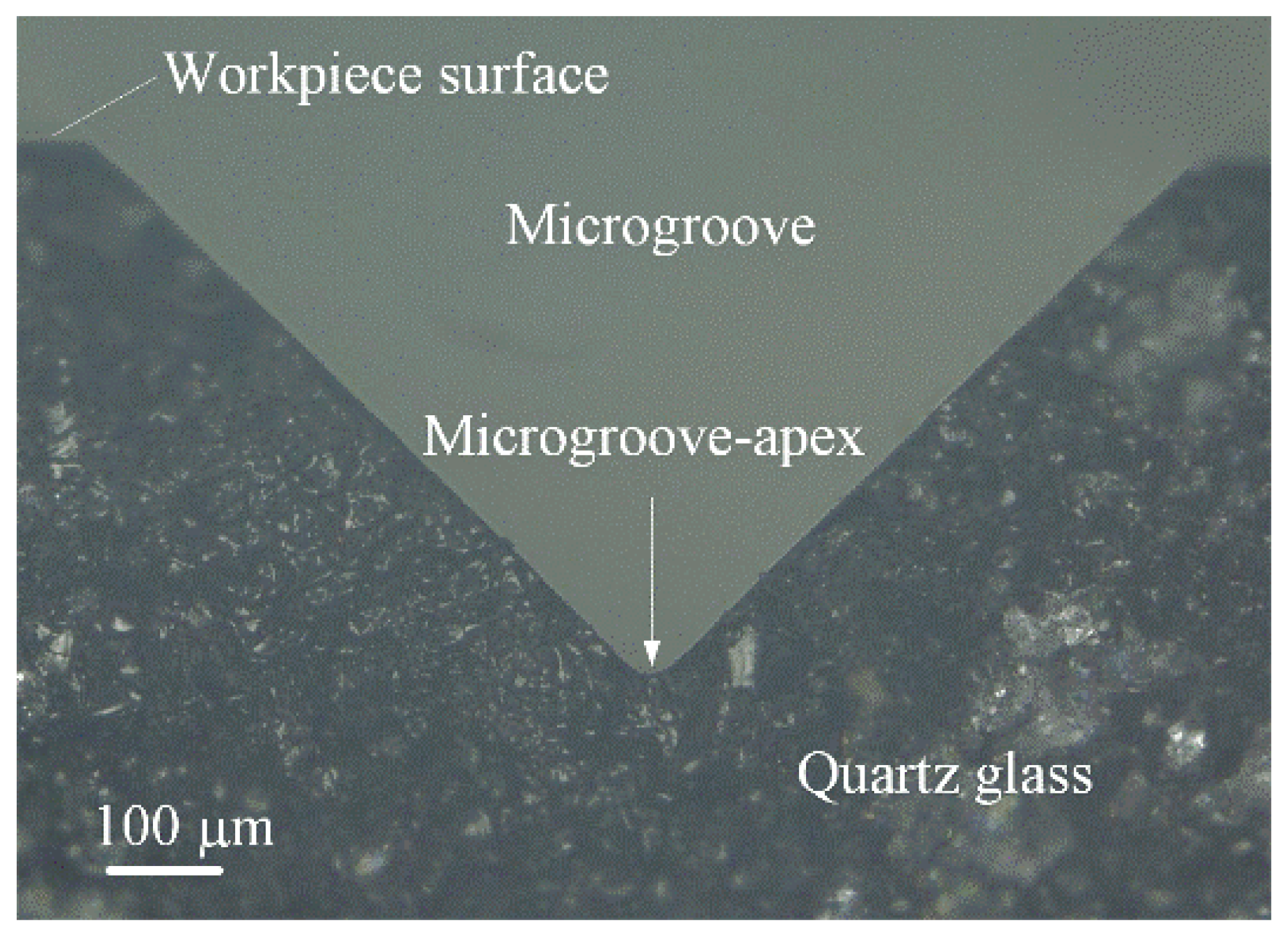
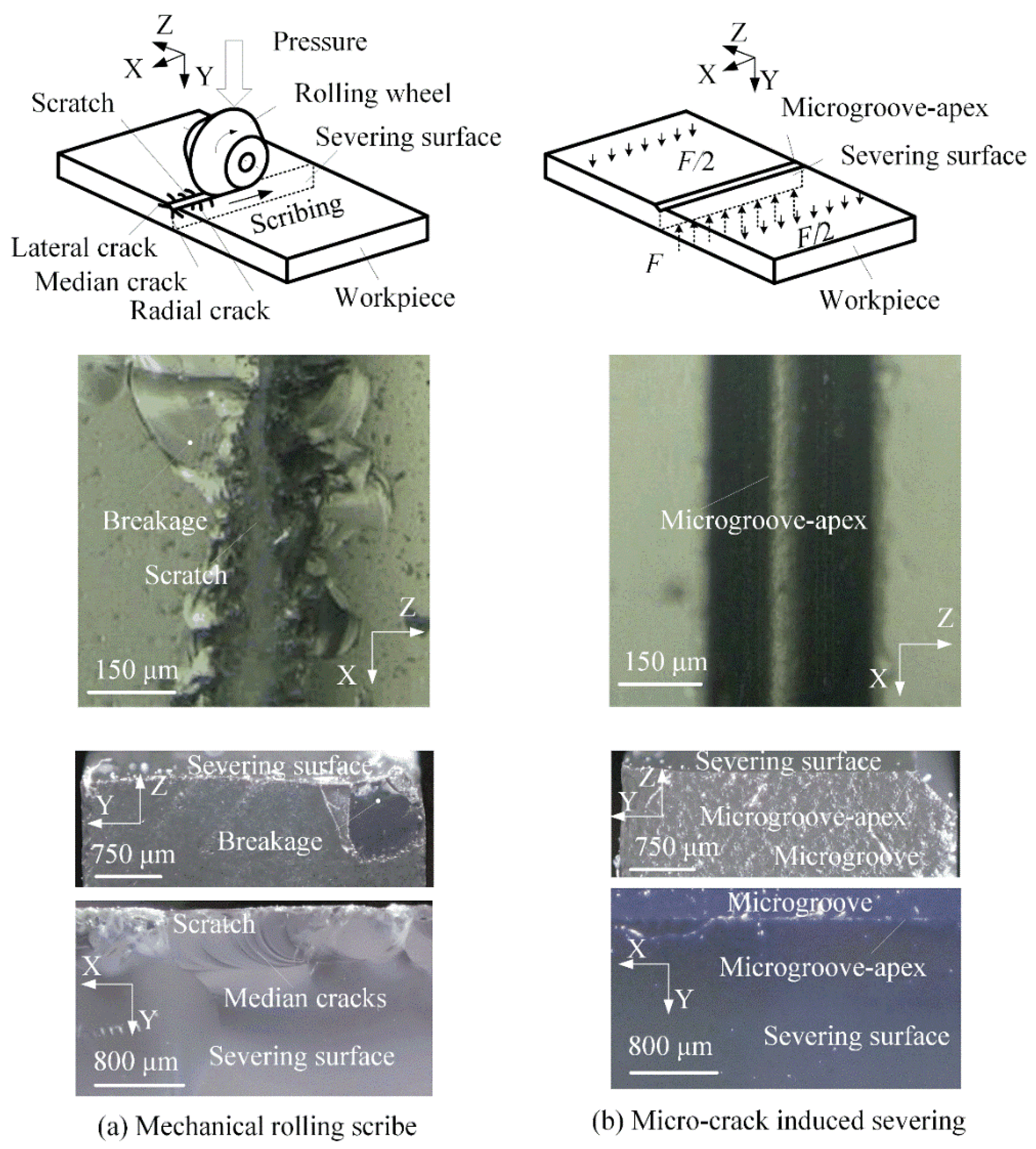
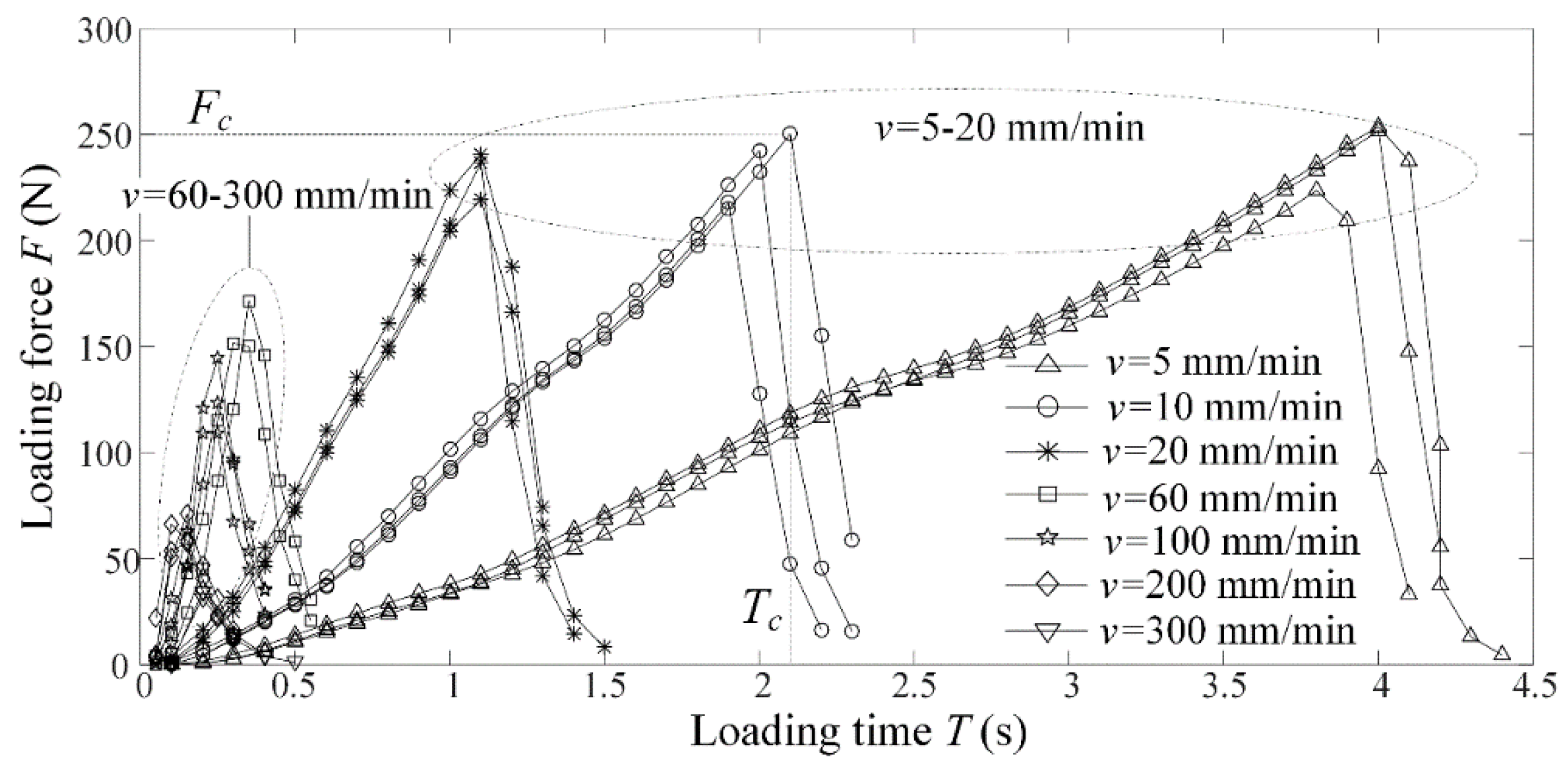

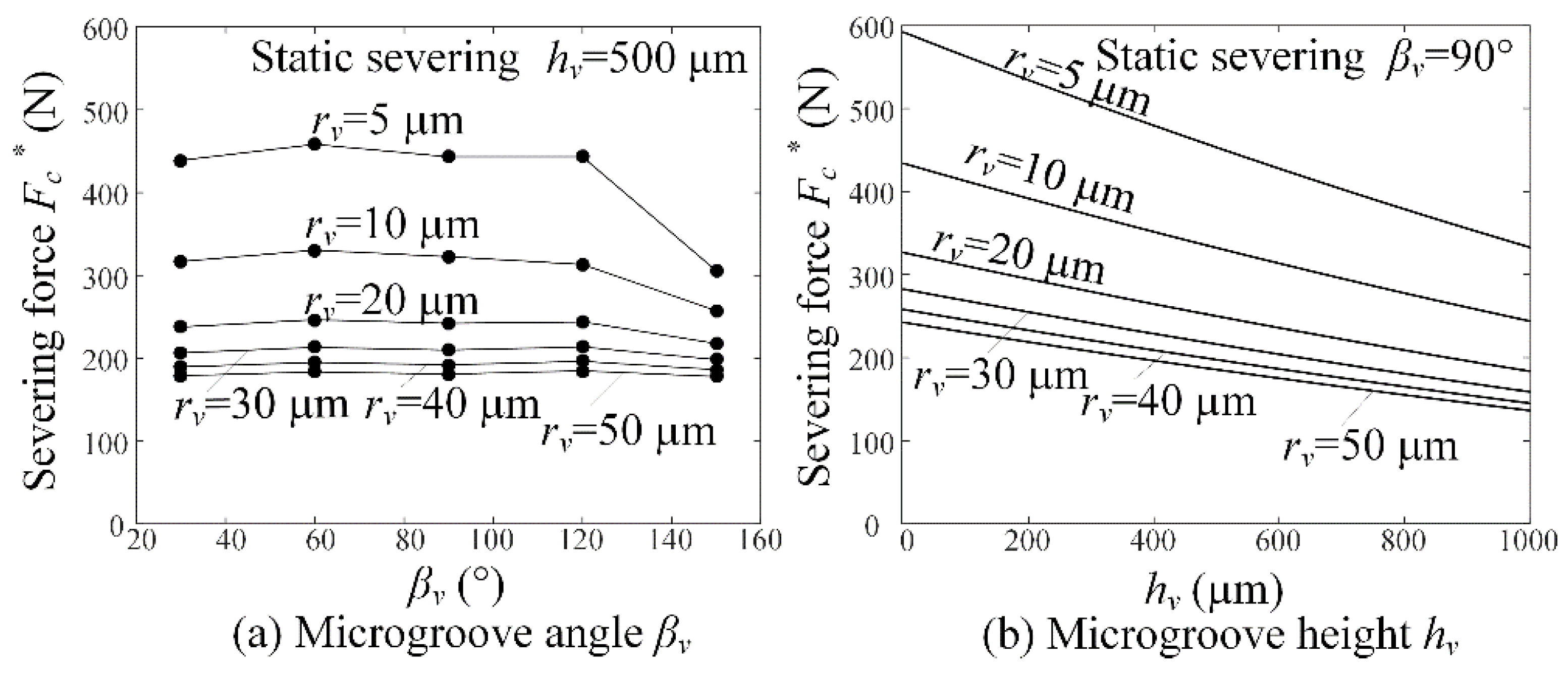
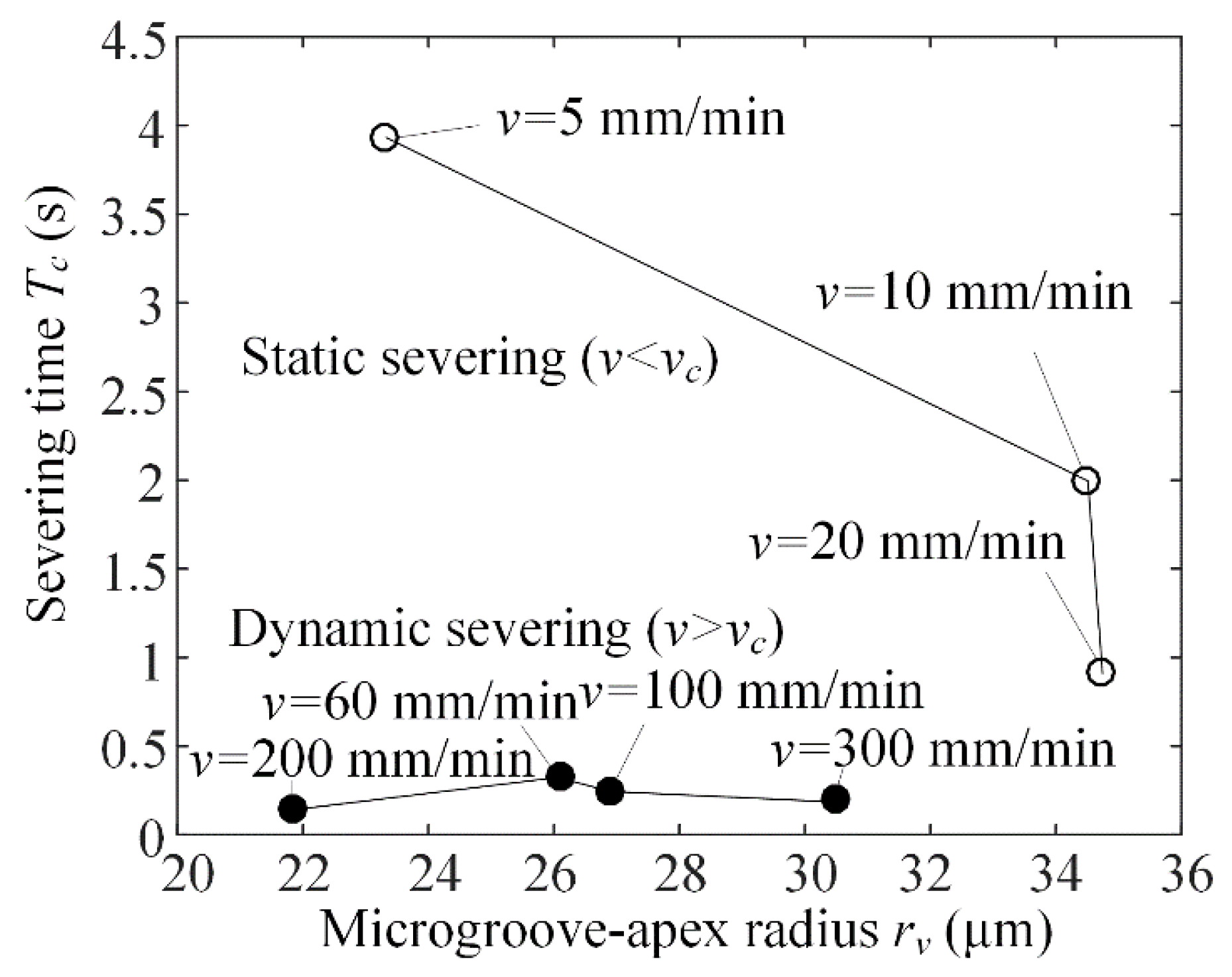

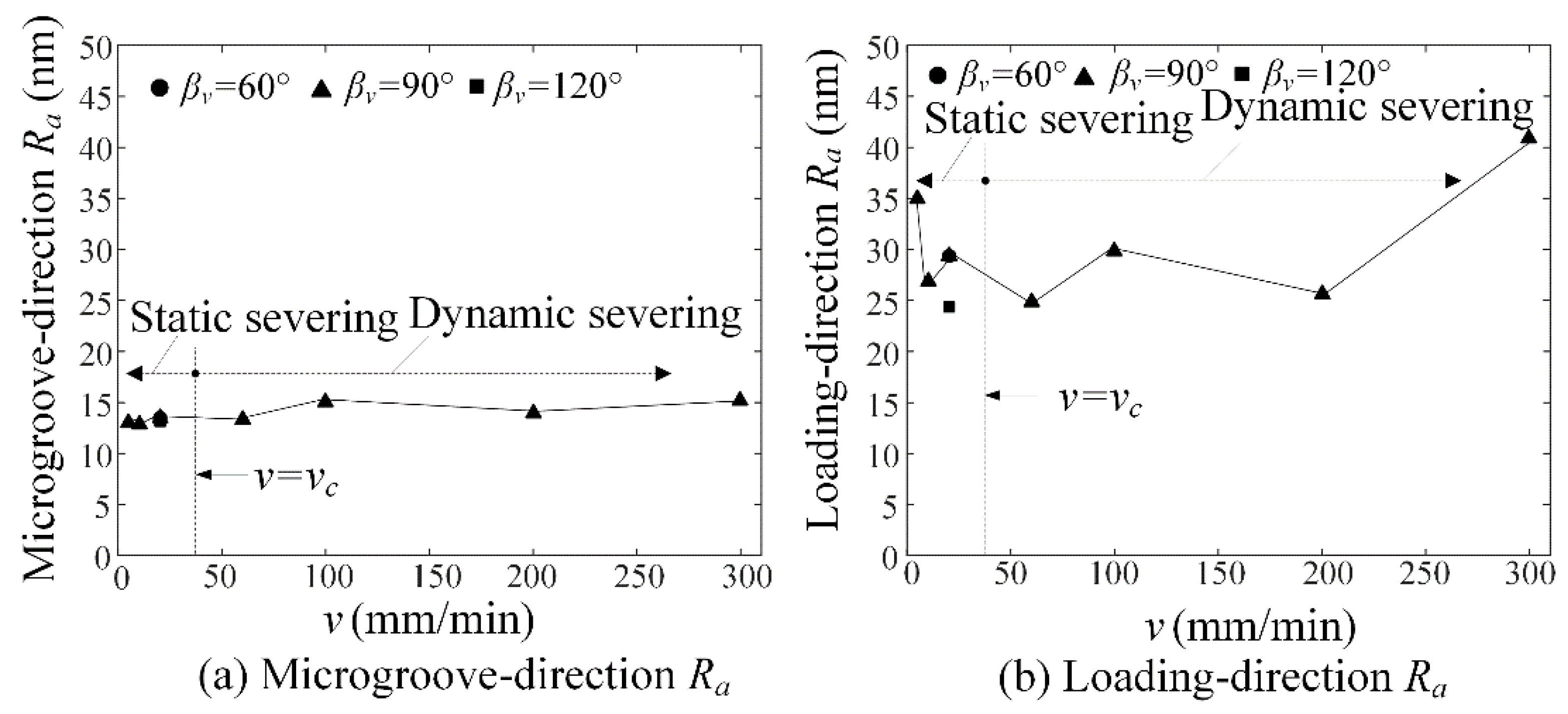
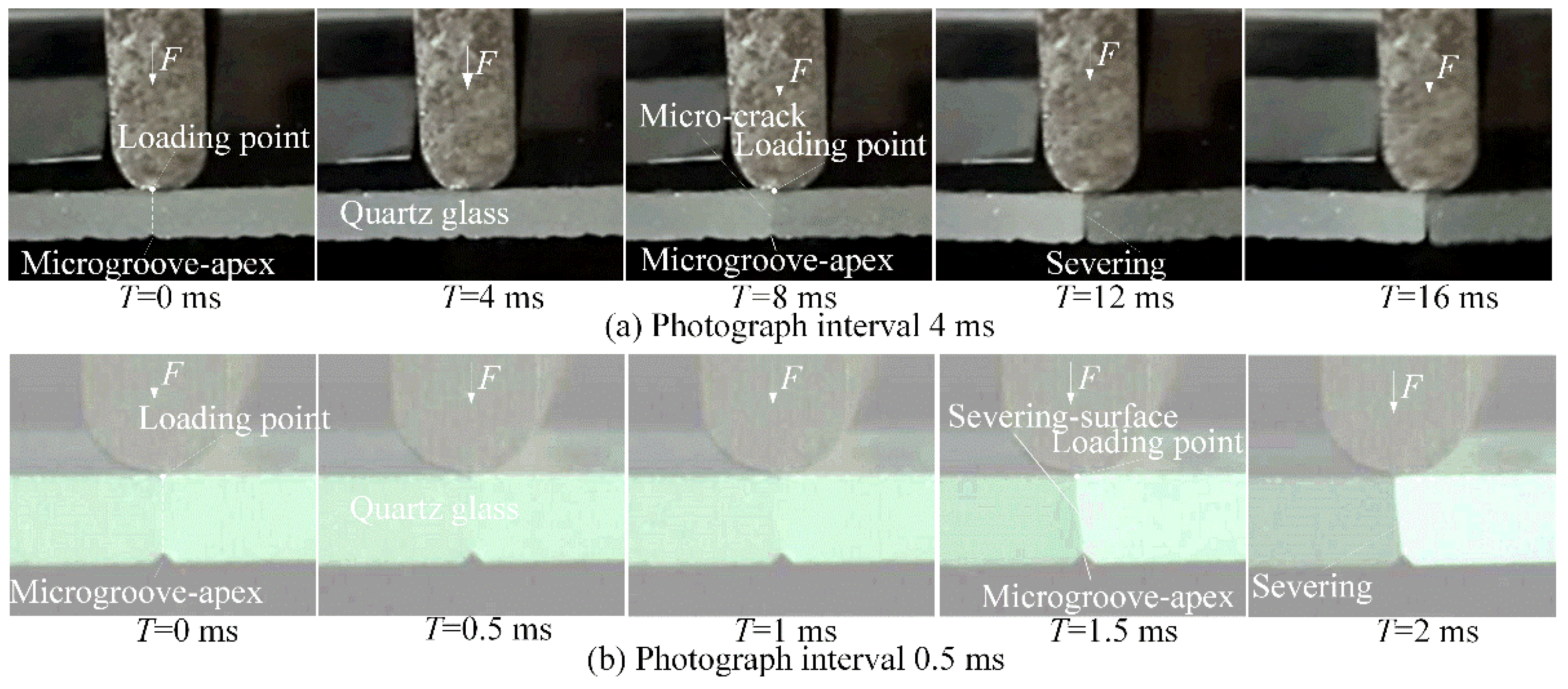
| CNC grinder | SMART B818 |
|---|---|
| Diamond wheel | SD600 (Metal-bond, Grain size: 24 μm), D = 150 mm, w = 4 mm |
| Dresser | #800 GC, Ceramic bond |
| Tool paths | V-shaped symmetrical, α = 60°, 90°, 120° |
| Truing parameters | vf = 500 mm/min, N = 2400 rpm, a = 20 μm, ∑a = 5 mm |
| Coolant | Water |
| CNC Grinder | SMART B818 |
|---|---|
| Diamond wheel | SD600 (Metal-bond, grain size: 24 μm), D = 150 mm, w = 4 mm |
| Workpiece | Quartz glass |
| Grinding parameters | vf = 500 mm/min, N = 2400 rpm, a = 20 μm, ∑a = 500 μm, |
| Coolant | Water |
| βv | λ1 | μ1 | χb1 | χc1 | χd1 |
|---|---|---|---|---|---|
| 60° | 0.5122 | −0.4057 | 1.3123 | 3.2832 | 0.0960 |
| 90° | 0.5448 | −0.3449 | 1.8414 | 2.5057 | 0.1046 |
| 120° | 0.6157 | −0.2678 | 3.0027 | 1.5150 | 0.0871 |
| Property | Value |
|---|---|
| Young’s modulus [GPa] | 77 |
| Poisson’s ratio | 0.17 |
| Ultimate tensile strength σu [MPa] | 50 |
| Fracture toughness KIC [MPa·m0.5] | 0.81 |
© 2018 by the authors. Licensee MDPI, Basel, Switzerland. This article is an open access article distributed under the terms and conditions of the Creative Commons Attribution (CC BY) license (http://creativecommons.org/licenses/by/4.0/).
Share and Cite
Zhang, L.; Xie, J.; Guo, A. Study on Micro-Crack Induced Precision Severing of Quartz Glass Chips. Micromachines 2018, 9, 224. https://doi.org/10.3390/mi9050224
Zhang L, Xie J, Guo A. Study on Micro-Crack Induced Precision Severing of Quartz Glass Chips. Micromachines. 2018; 9(5):224. https://doi.org/10.3390/mi9050224
Chicago/Turabian StyleZhang, Long, Jin Xie, and Aodian Guo. 2018. "Study on Micro-Crack Induced Precision Severing of Quartz Glass Chips" Micromachines 9, no. 5: 224. https://doi.org/10.3390/mi9050224




